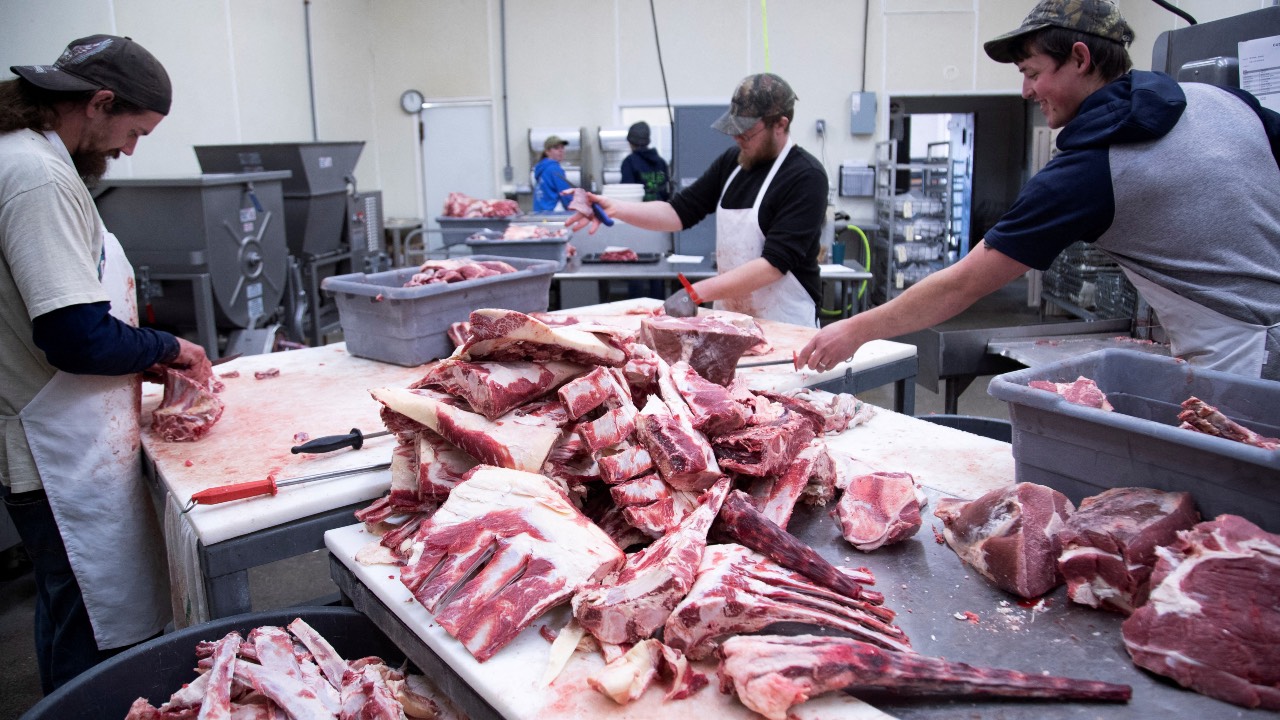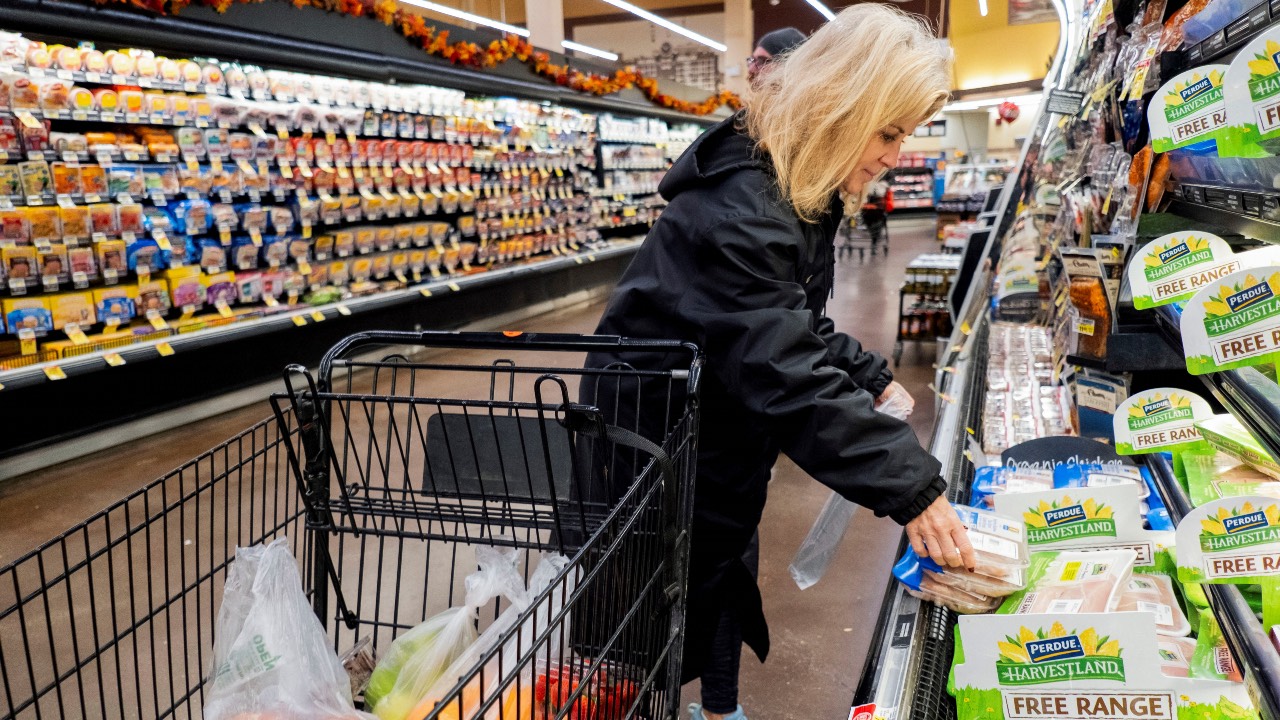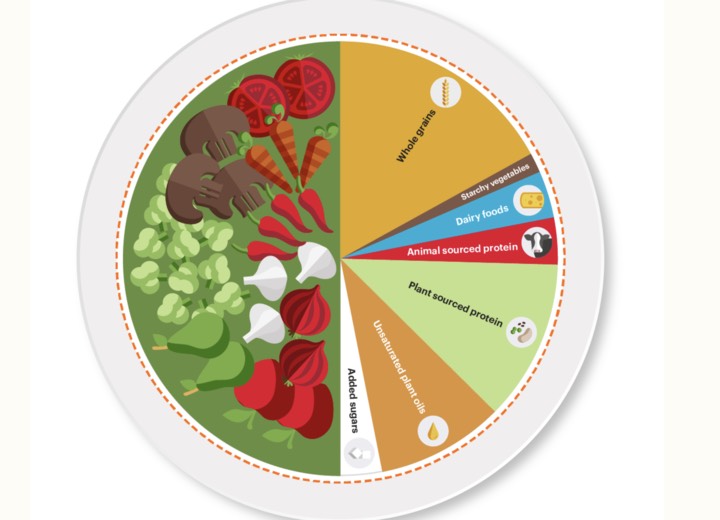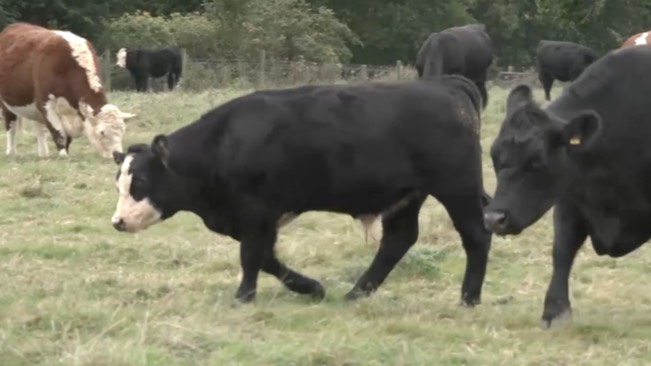03:32

In total, food production and distribution has led to around a third of all greenhouse gas emissions according to the United Nations. And despite widespread knowledge of the problem, the world's food footprint keeps rising year on year and will continue to rise unless there is a major shift in our diet.
So reducing emissions from the food system is a 'must-do' for our world.
Food needs to be produced, processed, transported, distributed and prepared before it finally gets to consumers. The entire food chain can be classified into three areas. Firstly there are land use change activities such as deforestation for dairy farming, which accounted for 36 percent of the Food Footprint in 2019.

Employees cut fresh beef meat into small pieces at the First Capitol Meat Processing plant in the U.S. state of Indiana. /Amira Karaoud/Reuters
Employees cut fresh beef meat into small pieces at the First Capitol Meat Processing plant in the U.S. state of Indiana. /Amira Karaoud/Reuters
Then there is agricultural production, with a contribution of around 52 percent, and lastly there are beyond-farm activities such as food processing, packaging, retail, transport, fertilizer manufacturing, and industrial wastewater treatment - which altogether account for around 13 percent of the food footprint.
In total, food consumption has led to about one-quarter to one-third of global anthropogenic greenhouse gas emissions.
Additionally, around a third of all food produced is either lost or wasted each year, according to the UN Food and Agriculture Organization (FAO). A recent paper in Nature Food indicates that emissions from food waste constitute nearly half of the emissions of the entire food system.
Meat is murder
It is important to acknowledge that what we eat has a direct impact on emissions.
A recent study published in Nature Food finds that global greenhouse gas emissions from food systems increased by two gigatonnes CO2 equivalent per year over the past 20 years, largely driven by the increase in the global consumption of animal-based products.
Scientists have found significant variations in emissions among different food products. When consumed in the same quantity, emissions from red meat are much higher than those from other food categories.

Stacey Cavanagh shops for meats ahead of the Thanksgiving holiday in Chicago. /Vincent Alban/Reuters
Stacey Cavanagh shops for meats ahead of the Thanksgiving holiday in Chicago. /Vincent Alban/Reuters
Livestock alone creates 14 percent of all greenhouse gases globally, with cattle being by far the largest contributor, according to the Food and Agriculture Organization of the United Nations (FAO).
At 58 percent, most emissions in livestock farming result from feed production, followed by digestive processes at 31 percent, processing and transport at seven percent, and storage of manure at four percent.
A study about the environmental impact in producing one kilogram of different foods shows that beef production remains the biggest source of greenhouse gases. The simplest and most effective way to limit your impact seems to be by reducing meat and dairy in your diet, particularly beef and lamb.
Most locally produced foods in Europe have emissions levels that are among the lowest in the world.
- Yuli Shan, University of Birmingham
However, YouGov polls in the UK indicate that people who never reduce their consumption of meat saw an uptick from 22 percent in 2022 to 26 percent in 2023.
We can make a difference
All food is not the same, explains Yuli Shan, Associate Professor in Sustainable Transitions at the University of Birmingham.
"Food that involves land use change activities in regions with abundant natural resources such as forests and peatland are highly intensive," Shan explains. "So products from Brazil, Indonesia, and the South and Central African regions can have large land use emissions during food production.
"Whereas due to highly intensive agriculture and advanced food production technologies, most locally produced foods in Europe have emissions levels that are among the lowest in the world."
But you still need to be vigilant when consuming European products because the meat in your pie or burger may not be from Europe. Brazil, the largest beef exporter to European countries, contributes significantly to processed meat products sold in the continent.
Scientists have proposed several healthy diets such as the EAT–Lancet planetary health diet. This diet is the product of 37 of the planet's foremost experts from multidisciplinary and multicultural backgrounds coming together to propose scientific targets for what constitutes both a healthy diet and a sustainable food system.

The EAT-Lancet planetary health diet includes scientific targets for what constitutes both a healthy diet and a sustainable food system. /EAT forum
The EAT-Lancet planetary health diet includes scientific targets for what constitutes both a healthy diet and a sustainable food system. /EAT forum
Shifting consumption from red meat to plant-based protein will not only reduce emissions but can also help consumers avoid health risks such as obesity and cardiovascular disease - yet the uptake is still slow.
"Several incentives can be taken, such as encouraging consumers to reduce red meat or buy products with higher environmental dividends through eco-labeling, adding taxes or subsidies reflecting some of the environmental costs in product prices, and education on actual food emissions," says Shan.
The concept of offering incentives to consumers has already been widely rolled out.
Taxes on sugary beverages to reduce consumption and combat obesity have been implemented in Mexico and the UK, in 2014 and 2018 respectively. Japan offers subsidies to farmers who grow specific fruits and vegetables to promote healthier eating habits.
The U.S. also designed a Supplemental Nutrition Assistance Program (SNAP) providing incentives to low-income or no-income individuals and families to purchase fresh produce at farmers' markets.
Back to grassroots
Denmark provides tax deductions for farmers who practice organic farming and adopt sustainable practices and the UK also offers similar incentives.
Will Dickinson's family have been working their land in Hertfordshire, UK for generations and have seen many changes in agricultural practices.
The family farm is about the size of 400 football pitches - and in addition to growing wheat, it also produces beef and lamb.

When buying meat, we can choose options with lower emissions, such as chicken or fish, and not eat red meat as often. /CGTN
When buying meat, we can choose options with lower emissions, such as chicken or fish, and not eat red meat as often. /CGTN
Dickinson has started to take up the UK government's incentives to go greener, and as part of this initiative, he is rewilding parts of his farm to encourage wild birds and wildlife.
"We are encouraged to plant special crops that are designed to provide seed that will be available to birds in the wintertime," says Dickinson.
The sad irony of a lot of the environmental schemes is their impact on the food production.
- Will Dickinson, UK farmer
Unintended consequences
However, these incentives feel counterintuitive to Dickinson.
"I'd argue that one of my principal aims in being a farmer is to produce food. The sad irony of a lot of the environmental schemes is their impact on the food production," laments Dickinson.
The farmer argues these can impact the ability of the UK to be self-sufficient in food production, which would be difficult to reverse as putting fields back into production in an emergency can take months or even years, leaving food prices vulnerable to external shocks.
It's also bad for emissions as our food will have to be transported, sometimes long distances, which is one of many issues.
"It [food] is often produced under systems that would be illegal in this country, either with the use of pesticides which are not approved in the UK or with regimes that are not allowed in the UK in terms of environmental protection or in terms of animal welfare," he points out.
How can we reduce our carbon footprint?
We can all make small changes such as:
Diversifying the composition and sources of our food, increasing the proportion of healthy foods like vegetables and fruits.
When buying meat, we can choose options with lower emissions, such as chicken or fish, and not eat red meat as often.
Consider opting for pasta or other grains instead of rice, which have higher emissions.
Avoiding food waste, cutting down on perishable items and only buying what we can eat.
Reducing consumption of expensive, air-freighted foods and opting for locally produced, cost-effective seasonal products.

Some European governments are offering tax deductions for farmers who practise organic farming and adopt sustainable practices. /CGTN
Some European governments are offering tax deductions for farmers who practise organic farming and adopt sustainable practices. /CGTN
Subscribe to Storyboard: A weekly newsletter bringing you the best of CGTN every Friday